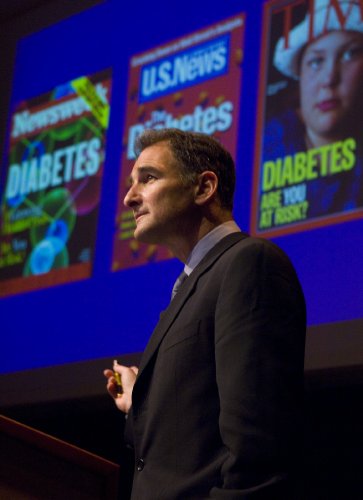
Gerald Shulman, M.D., Ph.D., delivers last week's Discovery Lecture. (Photo by Dana Johnson)
Understanding insulin resistance key to diabetes prevention
The portrait of an 11-year-old girl on the cover of the Dec. 8, 2003, issue of Time magazine points to a disturbing trend – the recent increase of type 2 diabetes, formerly known as “adult-onset” diabetes, in children still many years from adulthood.
“Thirty-four years ago, when a child of this age was diagnosed with diabetes, it was always type 1 diabetes,” said Gerald Shulman, M.D., Ph.D., at last week’s Discovery Lecture.
But times certainly have changed – and not for the better in respect to diabetes.
The surge in type 2 diabetes incidence, which parallels increases in inactivity and obesity, is not only a problem in the United States. By 2030, Shulman noted, diabetes incidence is projected to more than double in Asia.
“In less than 20 years time, over a third of a billion people will be impacted by diabetes,” said Shulman, who is the George R. Cowgill Professor of Physiological Chemistry, Medicine and Cellular & Molecular Physiology at Yale University School of Medicine.
This explosion in diabetes incidence – from 171 million in 2000 to a projected 366 million by 2030 – represents a 114 percent increase.
“You don’t have to be a diabetologist to realize that this has everyone’s attention,” he said.
At the lecture, Shulman shared insights from his 30-plus years of research on the cellular mechanisms of insulin resistance – a condition in which normal amounts of insulin are inadequate to allow body tissues to properly use glucose. The condition is a key factor in the development of diabetes.
Shulman and colleagues have studied the condition in mouse models as well as in patients, using magnetic resonance spectroscopy as a non-invasive, real-time method to study metabolism in humans.
Shulman and colleagues have found that impaired transport of glucose from the bloodstream into muscle is a major cause of insulin resistance in patients with type 2 diabetes. He has also found a strong relationship between fat inside the muscle cells and insulin resistance in skeletal muscle in both adults and children, proposing that alterations in intracellular fat metabolism are the major cause of insulin resistance.
“If we can understand these cellular mechanisms,” Shulman said, “we can find new ways of targeting treatment and prevention.”
For a complete schedule of the Discovery Lecture series and archived video of previous lectures, go to www.mc.vanderbilt.edu/discoveryseries.













